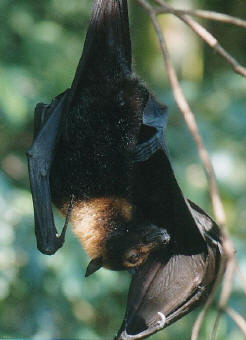Spectacled Flying-fox

Photo: Courtesy of Damon Ramsey
BSc.(Zool) Biologist Guide
Spectacled Flying-fox: Pteropus conspicsllatus Characteristics: Has prominent pale straw-coloured rings around its eyes suggesting spectacles. It is a placental mammal of wet tropical rainforests. Weight ranges from 400-600g, size (head and body length) from 220-240mm, and forearm length from 155-175mm.
Distribution and Habitat: - Three subspecies are recognised, but only one of these is in Australia, and this has a limited range.
It is restricted in Australia to the north-eastern wet regions of Queensland. It is found in New Guinea and offshore islands including Woodlark, Alcester, Kiriwina and Halmahera. It prefers to spend its time in the upper canopy of taller trees in the rainforest, but can also be seen in swamps and mangroves.
Diet: - They leave the camp at dusk to search for food, with most animals streaming off in different directions, high up and in a purposeful manner. Only a few bats will search for food near the camp in an apparently random way.
- They are guided by their keen sense of smell, good nocturnal vision and the feeding cries of other flying-foxes as they look for food.
- They prefer the nectar and pollen from blossoms and fruits of forest trees and palms, especially the Northern Bloodwood and the Apple Box.
- They also likes to eat citrus fruits and mangoes.
- Some bats drink water while skimming over the surfaces they leave or return to their camp.
- They have been seen drinking sea water in this way, and crocodiles have snapped them up while doing so. Other predators include the Carpet Python and the White-breasted Sea-eagle.
Social Behaviour: During the day, these bats spend their time in communal camps found in the upper canopy. A camp may consist of tens of thousands of individuals. They rarely sleep and are easy to locate as they squawk a lot of the time amongst themselves, making the din within a camp quite deafening.
Mating: Females can breed after two years. Mating occurs between March and May, with one young being born to each female from October to early December.
Viewing Opportunities: - The Tolga scrub in the late afternoon is a excellent viewing area.
Additional Information: - The Spectacled flying fox was listed as a threatened species in May 2002.
- When it takes off, it beats its wings until its body is horizontal, then releases its grip to fly forward (usually after dropping several metres first).
- They considerably damage smaller tree branches and after stripping a batch of trees, the colony will move 50-100m away to a new area.
- Spectacled Flying-foxes have been kept in captivity for 17 years.
Additional Information: Courtesy of Damon Ramsey They have lighter coloured fur on the back shoulders, while the rest of the body is blackish. Due to it's rainforest habitat, it is thought to be an important disperser of many of that ecosystem's fruits (Strahan 1998). It is the tropical rainforest equivalent and the replacement of the black flying fox, of which it looks very similar from a distance.
Script: Courtesy of Damon Ramsey BSc.(Zool) Biologist Guide |
